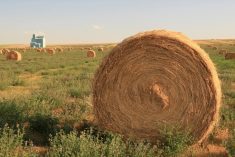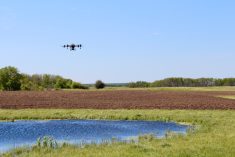More farmers and ranchers are looking at cover crops for many reasons, ranging from animal health, to reducing erosion, to capturing moisture. But how can people make them work on their operation?
Kevin Elmy sees the benefits of a more hands-on approach to cover crop management. Through Cover Crops Canada, he talks with farmers and ranchers across Western Canada about their cover crop needs.
There is no silver bullet for the best long-term or temporary mix, only guidelines, he said, and when farmers match the guidelines to their goals, they can make proper decisions and do positive soil management.
Read Also

The Canadian Cattle Association’s international advocacy efforts
Global ag policies affect Canadian food policy, so the Canadian Cattle Association participates in international and domestic forums
“When people get into regenerative ag and cover cropping, the power of observation starts getting sharper… People are interested in seeing what is happening in the soils, what’s happening in the field, and they’re wanting to spend more time out there.”
Every farmer looking into cover cropping has their own reasoning, said Elmy, and those reasons change from year to year after they see what cover cropping can do.
“It’s my job to drill down to find out what they are looking for, whether it’s reducing weeds, reducing their reliance on synthetics, all these different things get layered in there. And as the producers start playing around with it and seeing what these cover crops can do, next year it’s, ‘Well, I got this problem.’”
Making a plan
Five main plant groups make up a cover crop mix, said Elmy: grasses, legumes, brassicas, non-brassicas and forbs. Within each one of those groups, there are warm and cool season species. On top of that, each warm and cool group has annual, biennial and perennial options. This is where farmers can introduce plant diversity into their soils and crop stands, depending on what they need. Depending on seeding time and performance needs, farmers can introduce or take out plants that won’t provide those needed benefits, said Elmy.
If Mother Nature throws some curveballs at the cover crop plan, Elmy suggests finding “sideways substitutions.”
“If we have this blend put together and it’s dry, well, the easy button is to reduce your seeding rate by 25-30 per cent. If it turns out that it’s going to be wet, it just won’t stop raining, maybe we’re going to have to bring in a little extra seed, some different species that will tolerate flooding.”
The research
When it comes to the effectiveness of cover cropping, Elmy is seeing results with his customers.
Aklilu Alemu is working on the academic data.
As the research scientist for Agriculture and Agri-food Canada at the Swift Current Research and Development Centre, Alemu concentrates on ruminant nutrition and forage management. As part of an ongoing multi-year polycrop study, Alemu and his team are testing three seed treatment mixes under summer grazing as well as swath grazing scenarios. A single monocrop control is being tested against a simple and a complex seed mix of four to eight annual forages, respectively, with alternate planting of a monocrop followed by a polycrop, he said.
As well as testing for biomass yield, soil health and animal performance, Alemu said they will be testing for greenhouse gas emissions, both soil N2O and enteric methane from animals until 2027.
Testing in a traditionally dry area, they are seeing moisture deficits that can be negatively affected by cover crops. If it rains, everything works, he says with a laugh, but monocropping may yield better results during dry years. Polycropping is dictated by the weather conditions, so the question becomes, what happens if there is no moisture?
“That means maybe increasing your cereal proportion in the mix, because those are kind of resilient for dry conditions.”
Some earlier studies already show that cover crop mixes over nine or 10 varieties are not as effective or as cost-efficient as four to eight species mixes, he said. Polycropping can be expensive, so farmers want to make sure they are going to get some performance benefits from their polycrop mix.
Thierry Fonville, research scientist at Farming Smarter in Lethbridge, said they are testing over-winter cover-cropping techniques with a September planting date to capture moisture, limit soil erosion and add biomass for the spring season.
It’s a delicate balance, said Fonville, and farmers and ranchers must figure out how to fit a cover crop into their rotational grazing or crop rotation. Finding the right cover crop can be beneficial, he said.
“You’re paying so much for your land and your water, you don’t want to start limiting it just because you want to put in the cover crop. Unless, of course… all your soil is blowing away, and you need something to anchor your soil down. Then a cover crop is a very good solution to that. Your field wouldn’t be worth as much if you lose your topsoil every year.”
Farming Smarter’s Saving Soils project is funded in part by RBC’s Tech for Nature and the Weston Family Foundation’s soil health initiative. Fonville and his team are focused on how fall cover crops can bring nutrients back into the soil before planting a cash crop in the spring. Letting the cover crop stand until after planting — what Fonville calls living mulch — can help the main crop get established before it starts competing for moisture and nutrients, he said. They are also testing the best ways to terminate the cover crop, whether that’s discing, treating with herbicide, or finding the right time to roll or crimp the cover crop.
So far, rye and winter wheat have been hardy enough to survive frost, with high survival rates into April and May.
Elmy noted a similar beneficial practice in his own research. Quoting a challenge made by Kris Nichols, founder and principal scientist of KRIS (Knowledge for Regeneration and Innovation in Soil) Systems, farmers should have green plants growing for 260 days out of the year. This may seem impossible with Western Canada’s short growing season and small number of frost-free days, said Elmy. But even under the snow, the soil and plants are still active and can benefit from an overwintering plant.
“We can have these biennial plants growing and keep pumping these root exudates in the soil, because when a plant’s in the vegetative stage, it will release up to 80 per cent of the carbon against your photosynthesis into the soils and root exudates to feed our soil biology.”
On Elmy’s farm in the Yorkton area, he’s seen how proper cover crop management, as well as many other soil management practices, has helped build up the A horizon, or topsoil, in his fields. A larger A horizon means a bigger rooting zone, he said, which has obvious benefits.
“When we have a bigger rooting zone, we’re going to store more water, we’re going to have more nutrient availability. It’s a very sustainable, low-risk system.”
Again, it’s all about ensuring the cover crop is going to provide benefits to the soil, he said.
When testing a main crop’s reaction to the cover crop, different plant combinations reacted differently, said Fonville. In the living mulch research, longer-standing cover crops hurt canola and silage corn stands, but were beneficial to dry bean crops, he said. To Fonville, the research indicates the cover crop was competing for nitrogen with canola and silage corn, but the dry beans were unaffected since they have built-in nitrogen fixation. If there isn’t a negative yield effect, overwinter cover crops can be beneficial in fields where farmers cannot leave stubble or there are high amounts of soil disturbance, such as for potatoes, beet and even some bean crops.
With so many factors affecting cover cropping decisions, farmers need to find the right mix that will work with their operation. Elmy has seen common problems with many commercial cover crop blends, either ones he’s looked into or ones that farmers have brought to him to inspect. Many of them overuse brassicas, which is a nutrient scavenger just like canola.
Producers are researchers unto themselves, said Alemu, making decisions, and testing what works and what doesn’t.
But trying something new can be a daunting process, said Elmy. With so many factors, making correct cover cropping decisions all comes down to the farm and farmer’s own research and setting goals for that cover crop.
– Becky Zimmer is a freelance journalist based in Humboldt, Sask. Her farming and small-town background has given her a passion for Prairie journalism, provincial and national government policies, civic politics, community events and the challenges of rural health care and infrastructure.
















